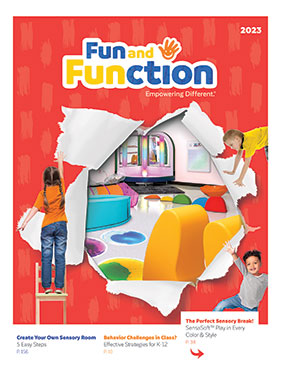Jump To:
Aren’t Airports Already Accessible
Inclusive Solutions from Door to Door
The airport industry is focusing more heavily on the passenger experience. It seems like a simple investment– happy passengers will spend more time in the airport and likely spend more money during that time. They’re also more likely to come back to that airport in the future, repeating the cycle.
However, just entering an airport often raises people’s stress levels. Airports are inherently unfamiliar environments with long lines, large crowds, and higher than normal noise levels. Significant portions of the population are further impacted by disabilities; about 20% of American adults have a disability and 14% of American students get special education services in school. Typically someone with a disability travels with at least one other adult or family member, meaning at least one more person affected by the stress of traveling with a disability.
Aren’t Airports Already Accessible?
Accommodations for visible disabilities, that impact mobility, vision, and hearing, are nothing new at airports. People can request and expect assistance. Mobility equipment is available, announcements can be made accessible to those who are deaf, security routines can be altered for those with guide dogs or mobility canes.
But what if you have a hidden disability, a cognitive or developmental diagnosis like autism or ADHD? Close to half of those with autism also struggle with anxiety, difficulty with transitions, and change. This can cause an increase in repetitive, “stimming” behaviors. Many on the autism spectrum also struggle with social skills and communication.
Bristol Airport recently opened its new sensory room to the public. Richard Thomasson, Head of Customer Operations at Bristol Airport, said, "An airport can be a busy and stressful environment, therefore having a safe and interactive place for children and adults, will help to reduce anxiety before boarding their flights and is an invaluable asset in reducing stress." Our Sensory Room Design Team included a color column, infinity tunnel, a wheel projector, and flexible seating to create a fully immersive calm environment.
Receiving the right support for a hidden disability in airports continues to be a challenge because it’s not always immediately obvious to others. If airports were to anticipate and manage the anxiety and stress brought on by air travel for people with hidden disabilities and their travel companions, then it could create a truly inclusive environment.
Inclusive Solutions from Door to Door
Prepping At Home
It’s important to take preventative measures, rather than reacting to the stress of an airport once you’re there. Start by watching simulation videos or listening to social stories to reduce the unfamiliarity. Seeing what the airport looks like and talking through the timeline of events (checking baggage, security, boarding, departure) can help make the experience less anxiety-provoking. If possible, consider visiting the airport before your departure date to get used to the look and feel of the space without the stress of being on time for a flight.
Airport Sensory Spaces
Strategically placed airport sensory spaces empower those who need to have access to the tools they need. By considering the overall passenger experience, airports are able to dedicate areas as sensory spaces. They could be small pods, full rooms, or sensory corners incorporated into the waiting areas. These spaces are a safe haven for anyone who needs to take a break to self-regulate.
Overstimulated passengers can enjoy soothing sensory tools like a musical touch wall, special fiber optic lighting, bubble tubes, and cozy seating. During a stopover or in the case of a delayed flight, many passengers may benefit from a space for active play. Jumping boards, gel floor tiles, and soft play equipment can create a safe environment for people to let out extra energy. Portable sensory kits can also be available to passengers so that they can continue receiving the sensory input they need even if not at the airport’s designated space.
Hidden Disability Training for Airport Employees
Equipping airports with sensory tools is not the only solution. Employees must be trained to recognize and respond to hidden disabilities the same way they are for visible disabilities. This type of training enables airport staff to recognize behavior cues of someone who is overstimulated or disoriented. Understanding the tools that are available allows staff to then offer strategies to reduce passengers’ anxiety, confusion, emotional dysregulation, or potentially aggressive behaviors.
Traveling with a disability, whether visible or hidden, makes people even more aware of efforts airports make to create a positive experience. Searching and advocating for inclusive and accessible places will continue to push the airport industry toward a truly inclusive passenger experience.
Explore our sensory room gallery to discover the possibilities.
Have you had a particularly positive or negative sensory experience at an airport? Let us know in the comments!
This post was originally posted on 07/26/2021 by . It was updated for accuracy and comprehensiveness on 02/02/2022.






















Comments